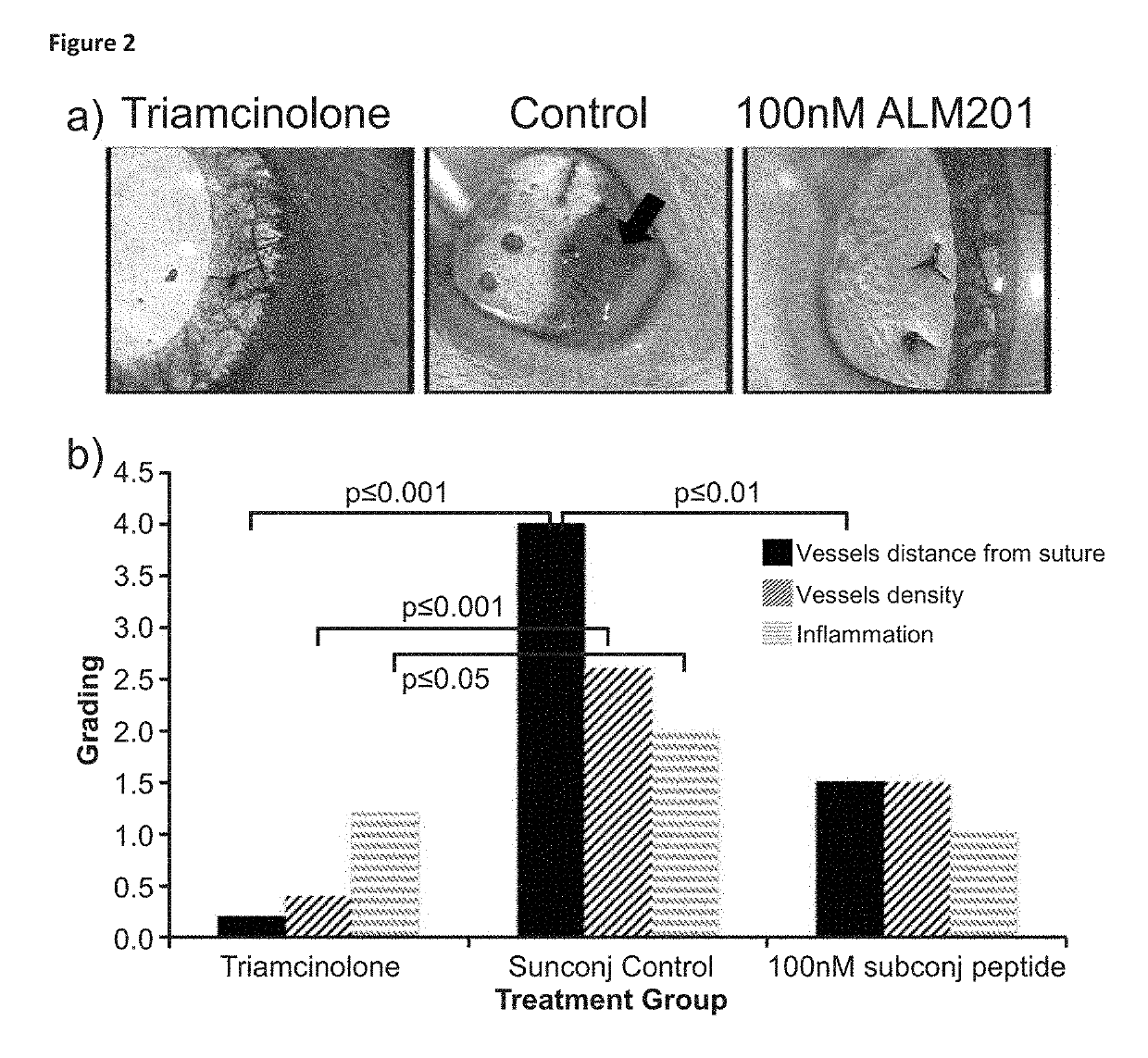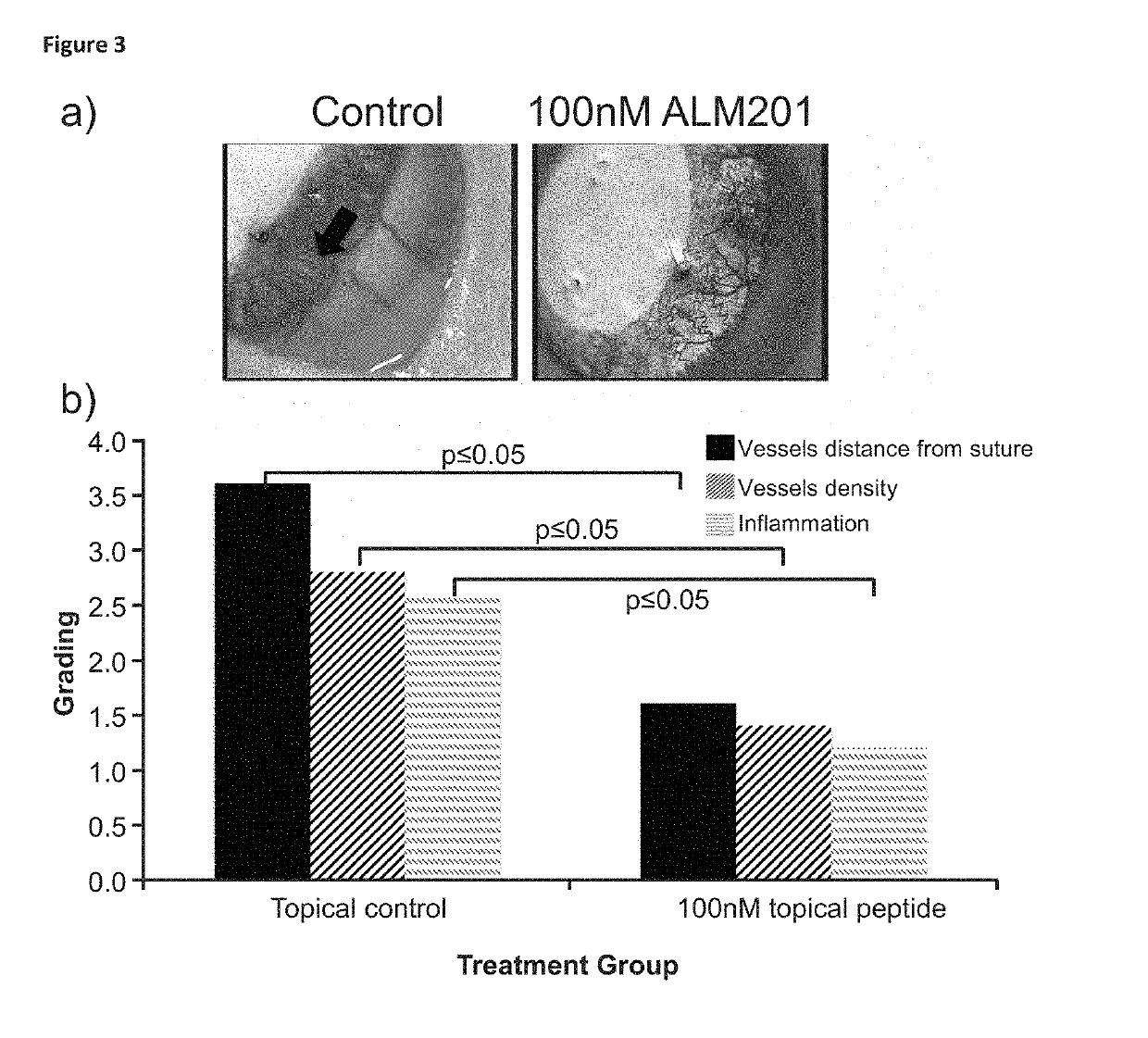Treatment of ocular disease
- Summary
- Abstract
- Description
- Claims
- Application Information
AI Technical Summary
Benefits of technology
Problems solved by technology
Method used
Image
Examples
example 1
ALM201 on Neovascularisation on the Ocular Surface
[0120]To assess the action of ALM201 (SEQ ID NO:3) on the ocular surface, the ability to halt vessel growth was measured. Vessel growth was stimulated through a well-accepted model (Shi et al., 2011) whereby a suture was placed in the central cornea of rat eyes (FIG. 1). We have shown the rat eye is similar anatomically to the human eye (Moore J E, McMullen C B, Mahon G and Adamis A P. The corneal epithelial stem cell. DNA Cell Biol. 2002; 21(5-6):443-51; incorporated herein by reference).
Experimental Groups
[0121]The experimental groups were:[0122]Subconjunctival injection of peptide (5 rats), control group (5 rats) and positive control group (5 rats)[0123]Intrastromal injection of peptide (5 rats), control group (5 rats) and positive control group (5 rats)[0124]Topical application of peptide (5 rats), control group (5 rats) and positive control group (5 rats)
[0125]Methods
[0126]A suture was placed in the central cornea of one eye of ...
example 2
ALM201 on Autoimmune Uveitis
[0140]The effect of ALM201 on autoimmune uveitis was tested in a mouse model of experimental autoimmune uveitis (EAU).
[0141]Methods
[0142]Animals
[0143]Sixty C57BL / 6J mice (38 female, 22 male, 9-12 weeks old) were purchased from the Biological Resource Unit (BRU) at Queen's University Belfast. All mice were maintained in a normal experimental room and exposed to a 12-hour-dark-12-hour light cycle. All procedures concerning the use of animals in this study were performed according to the Association for Research in Vision and Ophthalmology (ARVO) Statement for the Use of Animals in Ophthalmic and Vision Research, and under the regulations of the United Kingdom Animal (Scientific Procedure) 1986.
[0144]Induction of EAU
[0145]Mice were immunised with human Interphotoreceptor Retinoid Binding Protein (IRBP) peptide 1-20 (GPTHLFQPSLVLDMAKVLLD, GL Biochem, Shanghai, China) using a protocol described previously (Chen M., Copland D. A., Zhao J., Liu J., Forrester J. ...
example 3
ion of ALM201 in the Eye Following Topical Administration and its Effect on Inflammation
[0184]Matrix-assisted laser desorption / ionization (MALDI) mass spectrometry imaging (MSI) was used to map the distribution of ALM201 in the eye.
[0185]Methods
[0186]On day 0, sutures where placed into the cornea of rats to induce corneal neovascularisation and inflammation. The eyes were treated for 3 days or 6 days with 16 μl of ALM201 (100 nM and 100 μM) or PBS (vehicle control).
[0187]Eyes were enucleated on the 3rd or 6th day one hour after treatment and frozen in gelatine.
[0188]Cross sections (10 μm) were taken at the centre of the eye for MSI, adjacent sections were stained with haematoxylin and eosin (H&E).
[0189]All MALDI-MS imaging experiments were performed using either MALDI-TOF / TOF (Ultraflextreme, Bruker Daltonics) or MALDI-FT-ICR (Solarix XR 12T, Bruker Daltonics) mass spectrometer in positive ion mode using a Smartbeam II 2 kHz laser. The laser spot size was selected to yield intermedi...
PUM
| Property | Measurement | Unit |
|---|---|---|
| Fraction | aaaaa | aaaaa |
| Dimensionless property | aaaaa | aaaaa |
| Disorder | aaaaa | aaaaa |
Abstract
Description
Claims
Application Information
 Login to View More
Login to View More - R&D
- Intellectual Property
- Life Sciences
- Materials
- Tech Scout
- Unparalleled Data Quality
- Higher Quality Content
- 60% Fewer Hallucinations
Browse by: Latest US Patents, China's latest patents, Technical Efficacy Thesaurus, Application Domain, Technology Topic, Popular Technical Reports.
© 2025 PatSnap. All rights reserved.Legal|Privacy policy|Modern Slavery Act Transparency Statement|Sitemap|About US| Contact US: help@patsnap.com



